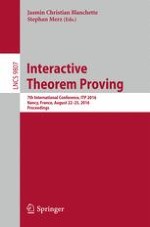2016 | Buch
Interactive Theorem Proving
7th International Conference, ITP 2016, Nancy, France, August 22-25, 2016, Proceedings
herausgegeben von: Jasmin Christian Blanchette, Stephan Merz
Verlag: Springer International Publishing
Buchreihe : Lecture Notes in Computer Science
